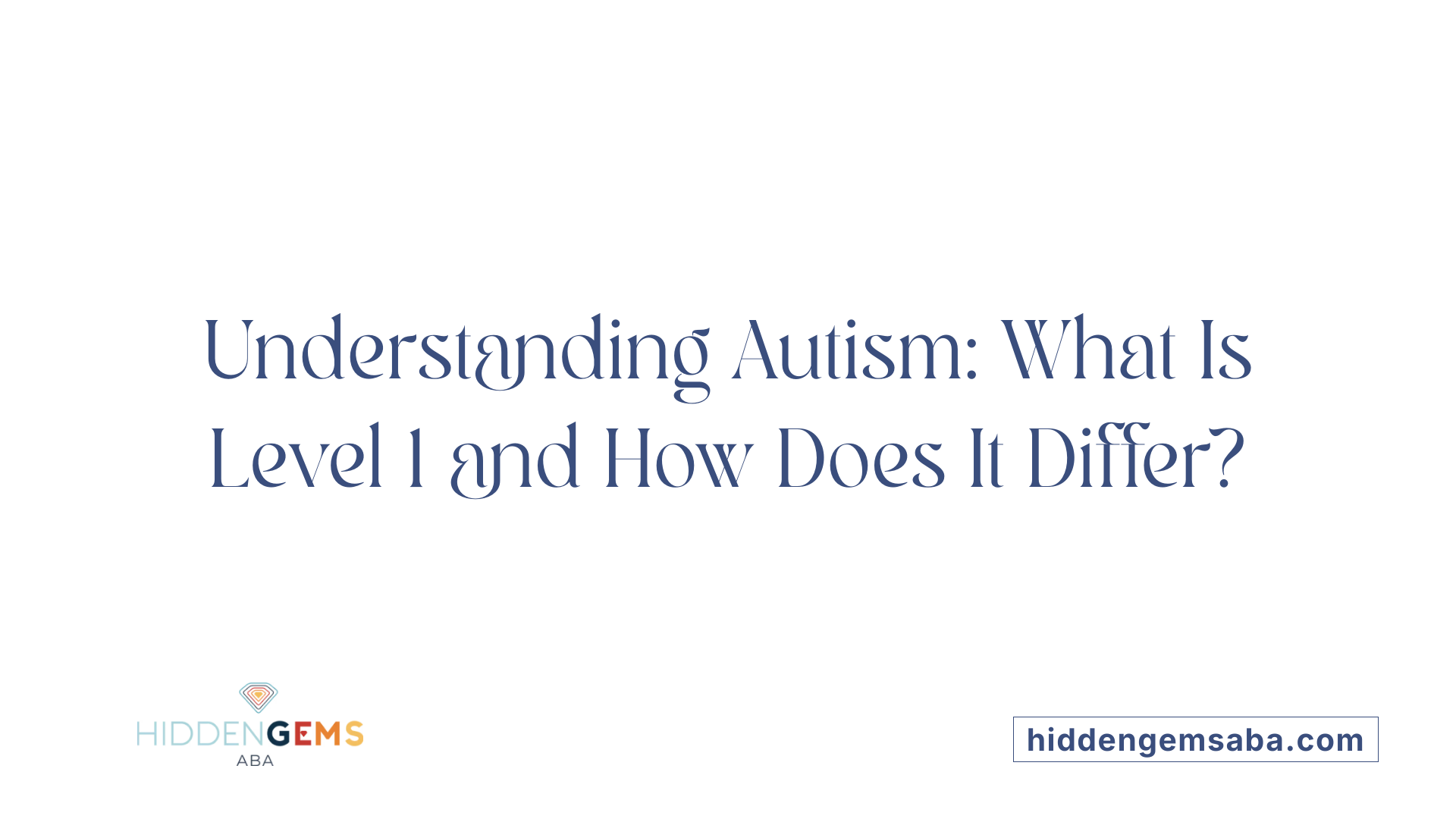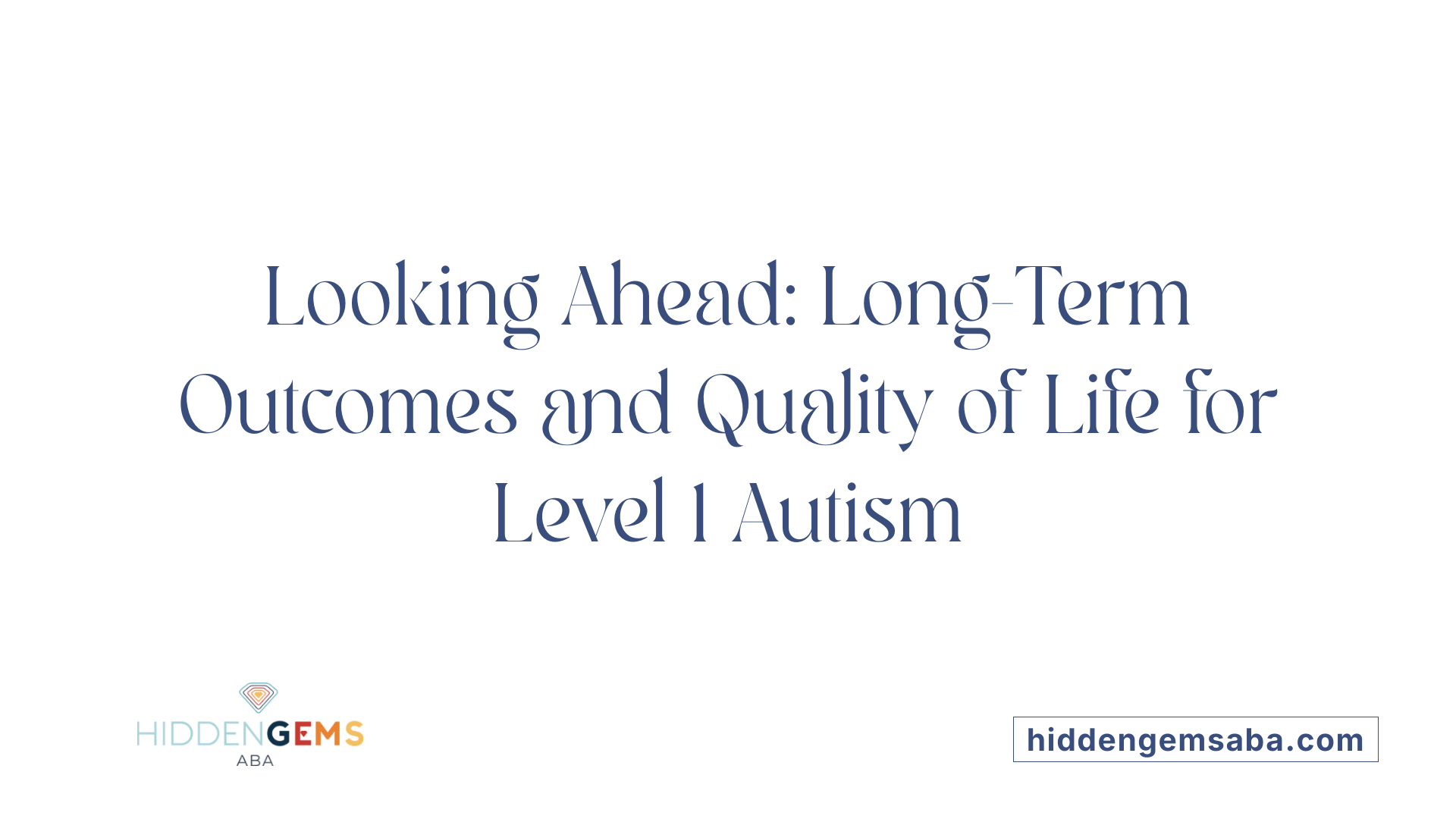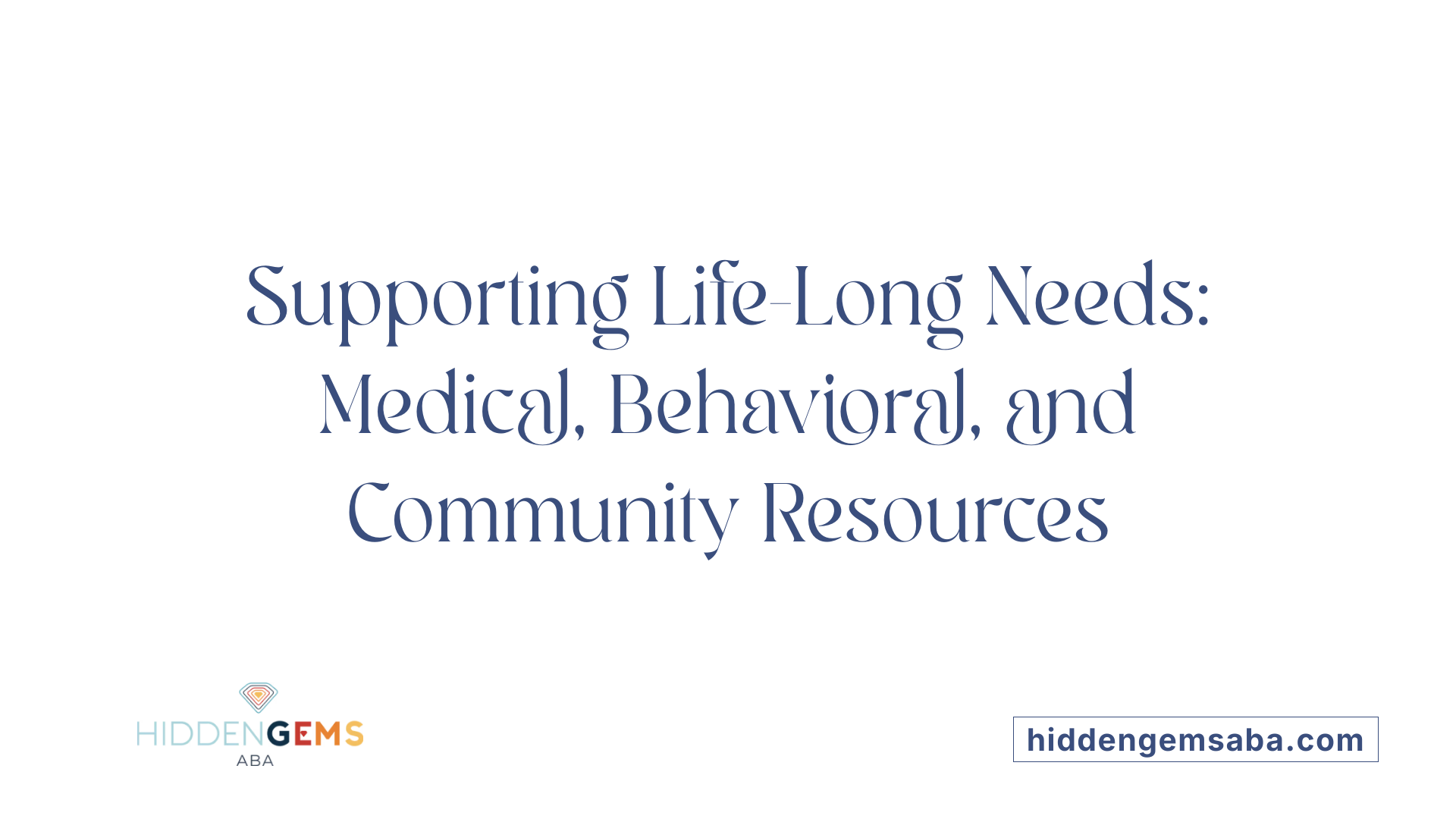An Introduction to Autism and Its Levels
Autism Spectrum Disorder (ASD) is a complex developmental condition characterized by challenges in social communication, behavioral rigidity, and repetitive behaviors. The condition is classified into three severity levels by the DSM-5, with Level 1 representing milder challenges that still significantly impact daily functioning. This article explores the life expectancy and overall health outlook for individuals with Level 1 autism, providing clarity based on the latest research and clinical insights.
What Is Autism Spectrum Disorder and What Does Level 1 Severity Signify?

What is autism spectrum disorder, and what does Level 1 severity mean?
Autism Spectrum Disorder (ASD) is a developmental condition that affects communication, social interaction, and behavior. It is a diverse condition, meaning that each person with autism experiences it differently. The DSM-5 classifies ASD into three levels based on how much support an individual needs.
Severity levels of ASD
There are three levels, ranging from Level 1 to Level 3. Level 1 autism is considered the mildest form, where individuals require support but can often function independently with some assistance. Level 2 indicates a need for substantial support, and Level 3 denotes very substantial support needs.
Characteristics of Level 1 autism
People with Level 1 autism may have trouble initiating social interactions and understanding social cues. They might struggle with flexibility, such as switching activities or adapting to changes in routines. Despite these challenges, many can speak in full sentences and manage daily tasks with some support. Their difficulties can still interfere with social and daily functioning, but early intervention and targeted support can make a significant difference.
Understanding the nuances of Level 1 autism helps in crafting personalized strategies that leverage strengths and address challenges. These strategies often include social skills training and behavioral therapies, which can improve quality of life for those on this level.
Prognosis and Health Outcomes for Level 1 Autism

What are the prognosis and health outcomes associated with Level 1 autism?
Individuals with Level 1 autism typically experience a relatively better outcome compared to more severe forms of autism, such as Level 2 or Level 3. Many are capable of leading independent lives when they receive appropriate support and early intervention.
Early psycho-educational therapies, like Applied Behavior Analysis (ABA) and speech therapy, play a crucial role in improving social communication skills and daily functioning. These interventions can significantly enhance long-term outcomes, making it easier for individuals to navigate social and occupational environments.
Several factors influence prognosis, including higher childhood IQ, early language development, and a supportive environment. These elements are associated with better outcomes and may help reduce the severity of symptoms over time. Although autism is generally a lifelong condition, some individuals, estimated between 3% and 25%, may experience an "optimal outcome" where they no longer meet diagnostic criteria as adults.
Despite this potential for improvement, many challenges remain. Social integration, employment, and mental health issues often persist, emphasizing the need for continuous support and tailored interventions throughout life. Understanding that autism is diverse and that needs evolve makes ongoing support vital for improving quality of life for individuals with Level 1 autism.
| Aspect | Typical Outlook | Influencing Factors | Notes | |------------------------------|--------------------------------------------------------------|--------------------------------------------|----------------------------------------------------------------| | Long-term adaptability | Often capable of independence | Early intervention, IQ, environment | Outcomes vary widely among individuals | | Support requirements | Support needed for communication and social skills | Severity of symptoms, co-occurring conditions | Many may require ongoing support | | Persistence of challenges | Social, employment, and mental health challenges may remain | Continuous interventions and support | Emphasis on lifelong support for optimal quality of life | | Possibility of |
Life Expectancy of Individuals with Level 1 Autism: What Current Data Shows

What is the life expectancy of individuals with Level 1 autism?
Individuals with Level 1 autism—those requiring support but not severely impaired—generally have a life expectancy close to that of the general population. Typically, they live into their 70s, with a slight reduction of about 6 to 10 years compared to neurotypical peers. Despite this, health factors such as epilepsy, mental health issues, and other co-occurring conditions can influence individual longevity.
Current data from large-scale studies suggest that the average lifespan for autistic individuals is somewhat shorter—around mid-50s—compared to the average age of around 70 for the general population. However, for those with Level 1 autism, the outlook is more optimistic. Many can expect a lifespan similar to those without autism, especially with proper healthcare and early intervention.
Is there research data on the life expectancy of individuals with Level 1 autism?
Yes, research indicates that people with Level 1 autism often have a near-normal life expectancy, experiencing only a modest reduction. The estimated decrease is roughly 6 years, mainly due to health issues that may accompany autism, such as neurological or mental health conditions.
However, it is important to note that most studies focus on diagnosed individuals, and underdiagnosis—more common in females and some minority groups—can affect the accuracy of these estimates. For example, those with additional intellectual disabilities tend to face a more significant reduction, sometimes up to 15 years earlier than their neurotypical counterparts.
In summary, while Level 1 autism alone does not significantly impact longevity, comprehensive health management plays a vital role in ensuring a healthy and fulfilling life span for individuals on this level. Continued research is essential for refining these estimates, but current evidence offers reassurance about the general life expectancy outlook for many with Level 1 autism.
The Impact of Co-Occurring Conditions and Support Systems

Medical Comorbidities in Autism
Individuals with autism often face various additional health challenges. Common conditions include epilepsy, gastrointestinal issues, allergies, asthma, and immune system disorders like autoimmune diseases. These health issues can complicate daily life and management strategies for autistic individuals. For example, gastrointestinal problems are frequently reported and can affect nutritional absorption and comfort.
Why Early Intervention Matters
Early intervention plays a crucial role in supporting children with autism. Programs that focus on developmental skills, social communication, and behavior management can significantly improve outcomes. The earlier support starts, the better the chances for children to develop communication skills, reduce problematic behaviors, and achieve greater independence later in life.
Support for Aging Autistic Adults
As autism now affects 1 in 31 children, many individuals are aging into adulthood and beyond. Support needs evolve over time, especially for those with more severe levels of autism. For example, Level 3 autism requires very substantial support due to severe impairments, while Level 1, with milder symptoms, still calls for assistance with social interactions and daily organization.
Support systems should be tailored to the level of autism and individual needs. They include medical care, behavioral therapies, social services, and community programs. Ensuring lifelong support is critical since individuals with autism face a noticeably shorter life expectancy—up to 36 years less for some—primarily due to co-occurring physical health conditions.
| Support Aspect | Typical Needs | Comments |
|---|---|---|
| Medical Management | Regular health check-ups, managing comorbidities | Vital for preventing complications and ensuring well-being |
| Behavioral Support | Therapy, social skills training | Enhances daily functioning and social engagement |
| Community and Social Services | Employment, housing, community programs | Promotes independence and quality of life |
| Lifelong Monitoring | Health and safety oversight | Particularly important for adults and aging individuals |
Managing health and providing appropriate support systems are essential in improving life quality for autistic individuals across all ages.
Broader Context: Autism’s Growing Prevalence and Its Implications

How has the prevalence of autism changed over recent decades?
Autism Spectrum Disorder (ASD) has seen a significant increase in diagnoses over the last thirty years. Currently, about 1 in 31 children are diagnosed with autism, marking it as the fastest-growing developmental disorder. This rise in prevalence highlights the importance of understanding autism better and ensuring adequate support systems are in place.
Why is it important to recognize the diversity of autism?
Autism is highly variable from person to person. Some individuals may require substantial support, like those with Level 2 or Level 3 autism, while others may need less assistance. For example, children with Level 3 autism experience severe impairments in social communication and restricted, repetitive behaviors, requiring very substantial support.
Level 1 autism involves noticeable social communication challenges and behavioral inflexibility but with fewer supports. These variations mean that autism is not a one-size-fits-all diagnosis, emphasizing the need for personalized approaches to care and intervention.
What are the challenges faced by individuals with autism?
Many individuals with autism face complex health challenges. For instance, children with autism are 160 times more likely to drown than their neurotypical peers, showing the importance of safety awareness. Additionally, nearly half of children with autism wander or elope from safe settings, risking injury.
Autism also coexists with numerous medical conditions, including epilepsy, allergies, gastrointestinal disorders, and neuroinflammation. These health issues can impact overall well-being and lifespan. Notably, autistic individuals tend to have a shorter lifespan, with life expectancy decreasing by 20 to 36 years compared to the general population. Most of this reduction is due to co-occurring medical conditions.
The role of awareness and tailored support strategies
Raising awareness about autism’s diversity and associated health risks is crucial. Early intervention and tailored support can help individuals progress and manage challenges effectively. Understanding the wide spectrum of autism helps ensure that each individual receives appropriate resources, safety measures, and care that respect their unique needs.
| Aspect | Description | Importance |
|---|---|---|
| Rising Rates | 1 in 31 children diagnosed | Highlights need for increased awareness |
| Variability | Levels 1, 2, and 3 autism with different support needs | Personalized care is essential |
| Safety Risks | High risk of drowning and wandering | Preventive safety measures are vital |
| Health Challenges | Co-occurring conditions like epilepsy and gastrointestinal issues | Require comprehensive medical support |
| Life Expectancy | Reduced by 20-36 years | Emphasizes importance of medical management |
Recognizing these factors is essential to improving the quality of life for individuals with autism and their families.
Looking Forward: Enhancing Quality of Life and Longevity
Understanding the nuances of life expectancy in individuals with Level 1 autism highlights the importance of early diagnosis, tailored support, and managing co-occurring health conditions. While many live into their 70s and beyond, ongoing research and community support are vital to improve health outcomes and quality of life. Raising awareness about the diverse needs within the autism spectrum ensures that individuals receive the appropriate interventions and support systems to lead fulfilling lives. With continued advancements, the prospects for individuals with Level 1 autism are promising, emphasizing the importance of an inclusive and supportive environment that fosters independence and well-being.
References
- Autism Fact Sheet
- ASD levels of severity
- Chapter 3 – Parliament of Australia
- Long-term outcome of autism spectrum disorder - PMC
- The Long Term Prognosis for Autism
- Mortality in Individuals with Autism Spectrum Disorder
- Autism severity can change substantially during early ...
- Level 1 Autism Explained: What to Expect and How to Help
- ASD levels of severity






